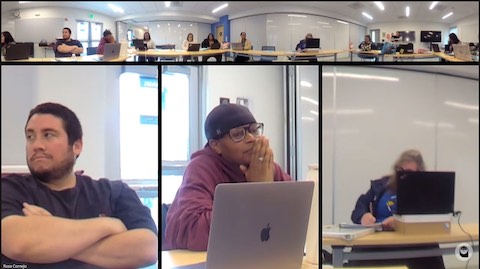
04 Nov Antioch Educators Rally For Better Pay, Fully Funded Benefits

Antioch educators packed the Oct. 29 school board meeting to demand higher pay and better benefits. (Photo courtesy of Antioch Education Association)
By Samantha Kennedy
For over an hour, dozens of Antioch Unified educators rallied at Wednesday’s school board meeting to demand that the district increase salaries and offer fully covered benefits to employees.
That’s after the district offered what the Antioch Education Association, which represents district teachers, called “insulting” proposals of a 1% one-time lump-sum payment and an 18-month extension of current health benefits.
The proposals are far from those settled on in previous years, which totaled more than a 26% salary increase over 5 years, according to the district. But, financially, the district is now in a different place.
Expenses have increased due to previous years’ salary increases and expanded healthcare, rising special education costs, and increases in utility costs, all alongside a loss in one-time funding sources, according to the district.
Approving any salary increases without funding in place would “deepen” financial shortfalls in the coming years, said Fiscal Services Director Mia Cancino.
For fiscal year 2025-26, Cancino said AUSD is projected to deficit spend by more than $12.2 million. That’s covered by district savings, which would then plummet from $23.8 million to $11.6 million. Over $9.7 million of that leftover savings must then be set aside for reserves.
“We refuse to accept a contract that doesn’t value our students and doesn’t value our members,” said AEA President Bob Carson. “We will continue to show up and fight because that is what is best for our students and our members.”
AEA proposed a 4% salary increase to the 2025-26 school year salary schedule, and full health benefits and dental through the end of the contract that would begin on Jan. 1.
Carson told the Pulse that the district’s proposals show it doesn’t value its educators or students. The 1% lump-sum payment, he said, is less than the 2.3% cost-of-living adjustment the district received in state funding.
Educators pointed to several other East Bay districts that offer better pay and fully paid benefits.
“The best teachers that we have right now will strongly consider working for the districts that have those fully paid benefits,” said Monica Cannady, AEA’s elementary school liaison. Nearby Pittsburg Unified offers full-time Pittsburg Education Association educators fully paid premiums.
Under the district’s proposal to Antioch educators, current health benefits would last for the next 18 months, but Carson said on social media ahead of the meeting that only 12 of those months would be fully funded. The district has not made any proposals on dental benefits.
But the two parties are also at odds over class sizes for special education students.
“We were given a proposal by the district that asked us to take in more special ed kids into our classrooms. Force them into the classroom,” said Carson.
The district’s proposal would mean teachers of students with disabilities couldn’t object to extra students in their classroom, he said to educators ahead of the meeting.
“That’s never happening,” Carson told the board.
Teachers say a potential increase in class sizes is not just unfair to educators but also can hurt student learning.
“Special education students depend on individualized instruction and support. That’s the entire reason these programs exist,” said Peter Dragula, a special education teacher at Lone Tree Elementary School. “When class sizes grow, the personal attention disappears, and teachers can’t meet IEP goals effectively.”
Cancino said that while the district is committed to its legal and moral obligations to the district, increasingly difficult trade-offs have to be made with the increase in costs, student diagnoses and staffing shortages.
Shortages are not new, nationwide or across the state. Over at least a decade ago, one report found that one in five California special education teachers were already leaving their positions.
AUSD has found itself in a similar situation to the West Contra Costa Unified School District, facing legal obligations to staff special education teachers during a shortage and turning to contractors.
Cancino said high costs associated with vendors are one of the reasons for increased expenses.
The proposed solution, unanimous across educators in AUSD, WCCUSD, and several reports, is to increase compensation.
The two started negotiations back up late last month to continue talks about its successor contract, which would last until 2027-28.






No Comments